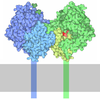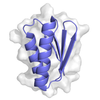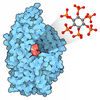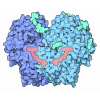[English] 日本語
 Yorodumi
Yorodumi- PDB-9gne: CryoEM structure of mammalian AAP in complex with acetyl-alanyl-c... -
+ Open data
Open data
- Basic information
Basic information
| Entry | Database: PDB / ID: 9gne | ||||||||||||
|---|---|---|---|---|---|---|---|---|---|---|---|---|---|
| Title | CryoEM structure of mammalian AAP in complex with acetyl-alanyl-chloromethylketone | ||||||||||||
 Components Components | Acylamino-acid-releasing enzyme | ||||||||||||
 Keywords Keywords | HYDROLASE / covalent inhibitor / serine-protease / flexible active site / oligopeptidase / self-assembly | ||||||||||||
| Function / homology |  Function and homology information Function and homology informationacylaminoacyl-peptidase / omega peptidase activity / serine-type endopeptidase activity / proteolysis / cytoplasm Similarity search - Function | ||||||||||||
| Biological species |  | ||||||||||||
| Method | ELECTRON MICROSCOPY / single particle reconstruction / cryo EM / Resolution: 3.2 Å | ||||||||||||
 Authors Authors | Kiss-Szeman, A.J. / Jakli, I. / Hosogi, N. / Banoczi, Z. / Harmat, V. / Memyhard, D.K. / Perczel, A. | ||||||||||||
| Funding support |  Hungary, European Union, 3items Hungary, European Union, 3items
| ||||||||||||
 Citation Citation |  Journal: Protein Sci / Year: 2025 Journal: Protein Sci / Year: 2025Title: Ligand binding Pro-miscuity of acylpeptide hydrolase, structural analysis of a detoxifying serine hydrolase. Authors: Anna J Kiss-Szemán / Luca Takács / Imre Jákli / Zoltán Bánóczi / Naoki Hosogi / Daouda A K Traore / Veronika Harmat / András Perczel / Dóra K Menyhárd /    Abstract: Acylpeptide hydrolase (APEH) or acylaminoacyl-peptidase (AAP) is a serine hydrolase that regulates protein metabolism. It can also bind to and process unusual substrates, acting as a detoxifier. To ...Acylpeptide hydrolase (APEH) or acylaminoacyl-peptidase (AAP) is a serine hydrolase that regulates protein metabolism. It can also bind to and process unusual substrates, acting as a detoxifier. To better understand its promiscuous specificity, we determined the cryo-EM structures of mammalian APEH complexed with classical serine protease partners: a chloromethyl-ketone (CMK) inhibitor, an organophosphate (OP) pesticide (dichlorvos), and benzenesulfonyl-fluoride. Since CMK derivatives of N-acetylated peptides were suggested to induce apoptosis by inhibiting APEH, while OP complexes may serve as biomarkers of OP exposure and are linked to cognitive enhancement, these complexes carry physiological significance. We identified a unique strand-breaker Pro residue in the hydrolase domain, which relaxes the active site into a partially inactivated but more spacious conformation, transforming the classical serine protease apparatus into a versatile yet potent hydrolysis center with broad specificity, distinguishing the mammalian enzyme not only from other APEHs but also from serine α/β hydrolases sharing essentially the same fold. | ||||||||||||
| History |
|
- Structure visualization
Structure visualization
| Structure viewer | Molecule:  Molmil Molmil Jmol/JSmol Jmol/JSmol |
|---|
- Downloads & links
Downloads & links
- Download
Download
| PDBx/mmCIF format |  9gne.cif.gz 9gne.cif.gz | 491.4 KB | Display |  PDBx/mmCIF format PDBx/mmCIF format |
|---|---|---|---|---|
| PDB format |  pdb9gne.ent.gz pdb9gne.ent.gz | Display |  PDB format PDB format | |
| PDBx/mmJSON format |  9gne.json.gz 9gne.json.gz | Tree view |  PDBx/mmJSON format PDBx/mmJSON format | |
| Others |  Other downloads Other downloads |
-Validation report
| Summary document |  9gne_validation.pdf.gz 9gne_validation.pdf.gz | 1.8 MB | Display |  wwPDB validaton report wwPDB validaton report |
|---|---|---|---|---|
| Full document |  9gne_full_validation.pdf.gz 9gne_full_validation.pdf.gz | 1.8 MB | Display | |
| Data in XML |  9gne_validation.xml.gz 9gne_validation.xml.gz | 82 KB | Display | |
| Data in CIF |  9gne_validation.cif.gz 9gne_validation.cif.gz | 126.2 KB | Display | |
| Arichive directory |  https://data.pdbj.org/pub/pdb/validation_reports/gn/9gne https://data.pdbj.org/pub/pdb/validation_reports/gn/9gne ftp://data.pdbj.org/pub/pdb/validation_reports/gn/9gne ftp://data.pdbj.org/pub/pdb/validation_reports/gn/9gne | HTTPS FTP |
-Related structure data
| Related structure data |  51464MC  9gouC  9hxqC  9s6bC M: map data used to model this data C: citing same article ( |
|---|---|
| Similar structure data | Similarity search - Function & homology  F&H Search F&H Search |
- Links
Links
- Assembly
Assembly
| Deposited unit | 
|
|---|---|
| 1 |
|
- Components
Components
| #1: Protein | Mass: 81324.391 Da / Num. of mol.: 4 / Source method: isolated from a natural source / Source: (natural)  #2: Chemical | ChemComp-A1INA / ~{ Mass: 131.173 Da / Num. of mol.: 4 / Source method: obtained synthetically / Formula: C6H13NO2 / Feature type: SUBJECT OF INVESTIGATION Has ligand of interest | Y | Has protein modification | N | |
|---|
-Experimental details
-Experiment
| Experiment | Method: ELECTRON MICROSCOPY |
|---|---|
| EM experiment | Aggregation state: PARTICLE / 3D reconstruction method: single particle reconstruction |
- Sample preparation
Sample preparation
| Component | Name: homotetramer of acylaminoacyl-peptidase (isolated from porcine liver) in covalent komplex with acetyl-alanyl-chloromethylketone Type: ORGANELLE OR CELLULAR COMPONENT / Entity ID: #1 / Source: NATURAL |
|---|---|
| Molecular weight | Experimental value: NO |
| Source (natural) | Organism:  |
| Buffer solution | pH: 7.5 |
| Buffer component | Conc.: 10 mM / Name: TRIS / Formula: TRIS |
| Specimen | Conc.: 0.5 mg/ml / Embedding applied: NO / Shadowing applied: NO / Staining applied: NO / Vitrification applied: YES |
| Specimen support | Grid material: COPPER / Grid mesh size: 400 divisions/in. / Grid type: Quantifoil R1.2/1.3 |
| Vitrification | Instrument: LEICA EM GP / Cryogen name: ETHANE |
- Electron microscopy imaging
Electron microscopy imaging
| Microscopy | Model: JEOL CRYO ARM 300 |
|---|---|
| Electron gun | Electron source:  FIELD EMISSION GUN / Accelerating voltage: 300 kV / Illumination mode: FLOOD BEAM FIELD EMISSION GUN / Accelerating voltage: 300 kV / Illumination mode: FLOOD BEAM |
| Electron lens | Mode: BRIGHT FIELD / Nominal magnification: 80000 X / Nominal defocus max: 2500 nm / Nominal defocus min: 500 nm |
| Specimen holder | Cryogen: NITROGEN |
| Image recording | Electron dose: 40 e/Å2 / Film or detector model: GATAN K3 (6k x 4k) |
- Processing
Processing
| EM software |
| ||||||||||||||||||||||||
|---|---|---|---|---|---|---|---|---|---|---|---|---|---|---|---|---|---|---|---|---|---|---|---|---|---|
| CTF correction | Type: PHASE FLIPPING AND AMPLITUDE CORRECTION | ||||||||||||||||||||||||
| Particle selection | Num. of particles selected: 2151591 | ||||||||||||||||||||||||
| Symmetry | Point symmetry: D2 (2x2 fold dihedral) | ||||||||||||||||||||||||
| 3D reconstruction | Resolution: 3.2 Å / Resolution method: FSC 0.143 CUT-OFF / Num. of particles: 412960 / Num. of class averages: 7 / Symmetry type: POINT | ||||||||||||||||||||||||
| Refine LS restraints |
|
 Movie
Movie Controller
Controller




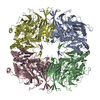

 PDBj
PDBj